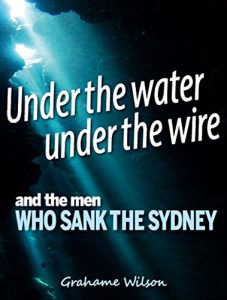- Author
- Book reviewer
- Subjects
- WWII operations, History - WW2, Book reviews
- Tags
-
- RAN Ships
- None noted.
- Publication
- September 2017 edition of the Naval Historical Review (all rights reserved)
By Grahame Wilson. Self-published via Publicious P/L in 2015. Paperback, 281 pages with b&w illustrations. Available from Amazon and Booktopia and selected booksellers from $30. EBook version is also available on Amazon and iTunes.

This fact-based story deals with German U-boat warfare as told by their captains and crews. It is well-researched from sources in Australia and Germany. Under the WaterUnder the Wireand the men who sank the Sydney relates to the escape of German prisoners from a POW camp in Victoria, Australia at the same time a German long-range U-boat was patrolling nearby off the Australian east coast.
The author was a schoolboy in New Zealand during WWII, finally graduating from Sydney University as a science teacher. Later he went on to produce films at the University, mostly on science-based subjects. While underwater diving in Sydney Harbour, he discovered wreckage that led him to become interested in Japanese submarines and subsequently German submarines visiting Australia. Years later after a hang-gliding accident in 1981 that left him a quadriplegic, he resumed his research, resulting in this fascinating account as seen through the eyes of the German sailors.
The story begins late in the war as U-862 leaves Germany under the command of Lieutenant Heinrich Timm, a former officer in the Merchant Navy. Timm’s personality as an understanding well-liked captain comes through in all his actions. Other U-boat commanders operating with Timm from their base in Penang show the differing personalities of those who chose to live their lives largely under the water. When encountering the enemy and sinking their ships, commanders of U-boats have to be dispassionate. Helping survivors can be very challenging. Examples of such actions show the dilemma and the hard decisions that have to be made.
Admiral Doenitz was the well-respected head of the U-boat fleet and directed their operations in all theatres. After heavy losses in the Atlantic, he decided to send a force to the less patrolled Indian Ocean, where most of the action in this story takes place. With the Japanese takeover of South-East Asia in 1942, Penang became a base for German U-boats and the Singapore dockyard facilities were available to them for ship repair and maintenance.
On arrival at Penang, Timm, along with German officers and U-boat crews, was welcomed and lavishly fêted by the occupying Japanese. At this stage of the war many American submarines were based in Fremantle and causing heavy losses to Japanese shipping in the Pacific, denying much needed supplies. Timm and U-862 subsequently moved south to latitudes below Australia to search for new targets. Finding none he began patrolling off the east coast of Australia and later New Zealand.
The story then takes us to the encounter between HMAS Sydney and the German raider Kormoran in March 1941 off the west coast of Western Australia. Sydney had not suspected that the supposed Dutch merchant ship was in fact a camouflaged German raider under the control of Captain Detmers.
As the story unfolds, as told by Captain Detmers, the battle resulted in both ships being sunk. There was not one survivor from Sydney, whereas Kormoran,which was able to launch lifeboats before it sank, lost about 60 men. Survivors drifted eastward for several days before being picked up by searching ships and taken into custody. The 300 or so Kormoran survivors were subsequently imprisoned in northern Victoria. The lower ranks in a large barbed wire compound, the officers nearby in an old abandoned mansion, Dhurringile. Three years later the officers dug a tunnel and 20 escaped – this great escape is known by very few. Detmers and Bertram were heading for the east coast – at the same time as Timm and his U-boat were patrolling in nearby waters. All escapees were rounded up with Detmers and Bertram being the last to be recaptured.
The epilogue follows the lives of the former prisoners after the war. During their time behind the wire, friendships had formed between prisoners and guards. Almost two hundred of those who had been in the Merchant Navy chose to remain in Australia, becoming Australian citizens. Those who returned to Germany organized annual reunions. In 1974 they visited Australia where they were greeted by an Australian Army band playing Old Comrades and, with their hosts, taken on a tour of their former prison camp.
The book makes fascinating reading. The characters are depicted authentically and compassionately. It is a valuable contribution to a little-known aspect of Australia’s wartime history.
Reviewed by Gordon Hill, with the assistance of Coral Johnson




